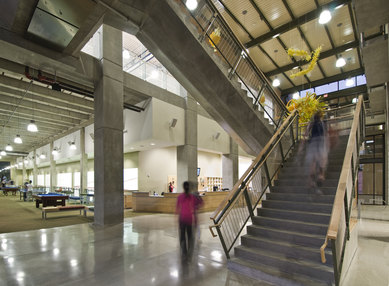WELL Building, A New Design Standard for Wellness
Many years ago, as a young architect-in-training, I was stressing. I was researching, writing and designing for my final Master’s Degree thesis at Clemson University. My chosen topic analyzed the effects of sedentary lifestyles and how buildings can physically engage their users by creating activity and promoting wellness just by simply being there. Architecture school is a time for experimentation and testing ideas; although mine was not the most radical, this topic interested me because of my previous professional experience in designing recreation and wellness centers. These are places where people make purposeful decisions to engage in physical activity and improve their health and wellbeing.
Fast forward to today, holistic wellness is mainstream and our buildings are physically contributing to the health and wellness of their occupants, sometimes without us knowing. There is even a rating system to help guide the way.
The new WELL Building Standard, developed by Delos and the International WELL Building Institute (IWBI), is the first of its kind and is solely focused on improving human health and wellness through the built environment. The WELL Building Standard measures impacts through seven categories of occupant wellness. The categories are:
- Air
- Water
- Nourishment
- Light
- Fitness
- Comfort
- Mind
Buildings can earn ratings of Silver, Gold and Platinum similar to the USGBC’S LEED rating system although the required measurables are strictly geared towards human health and not related to efficiency or consumption of resources. Later this year, the IWBI will even launch a WELL Accredited Professional (WELL AP) credential, with the test being available starting in November. They are looking for a few good women and men to promote the cause and carry the torch of health through our buildings. I had hopes that our industry would one day get to this point and I hope to be among the first WELL AP’s and one of loudest drum beaters.
WHY WELL BUILDING?
Today, the average American spends up to 90% of his or her time indoors. Due to this alarming statistic, the buildings that we occupy have arguably the most substantial opportunity to positively impact our health and wellbeing. Why shouldn’t our residences, our offices, our schools and universities make us healthier? They should. The WELL Building Standard (and thoughtful designers) can help by providing guidelines for water and air quality, rules for providing healthy food and drink, and opportunities for fitness and stress mitigation.
For me personally, the most interesting buildings and spaces are ones that actually do something. They engage users in a new way or allow us humans to do something that we could not have done before or at least not to that level of efficiency. I like to think that architects solve problems, and what topic is more important than our health? The spaces that we occupy should serve as vehicles to increased personal health. Other building design and construction metrics have done an outstanding job at increasing our industry’s focus on sustainability and the natural environment. My hope is that the WELL Building Standard can do the same for our personal health and wellbeing.
Interested in learning more? Shoot clint.menefee [at] smithgroupjjr.com (me) a question here or dive into the WELL Building Standard.
